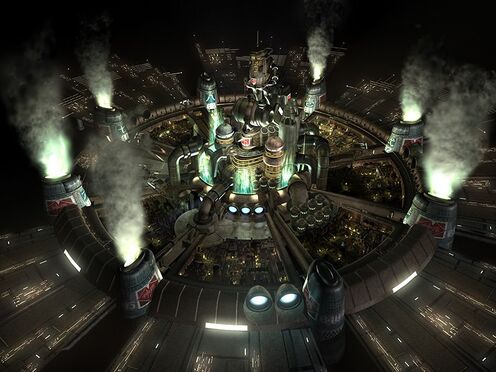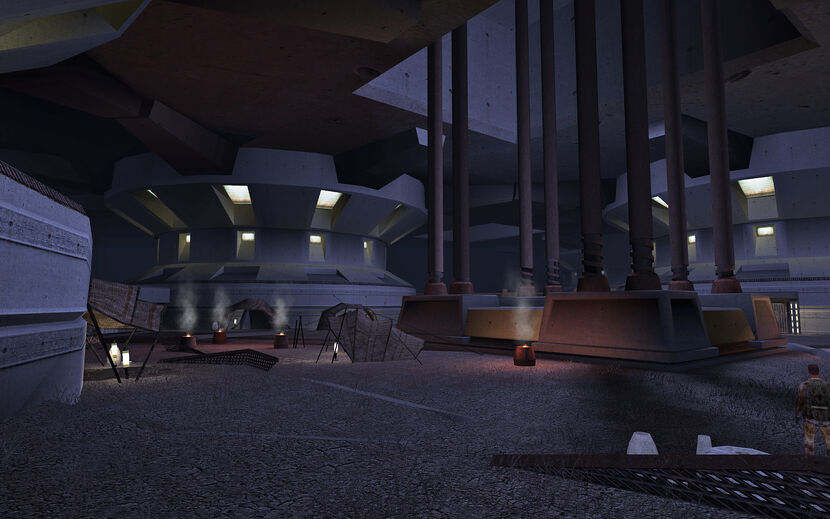Anyway, I finally finished the Xbox version of Star Wars: Knights of the Old Republic for the first time a couple of weeks ago, and I suppose it’s time I try and write up my review. So here goes.
KOTOR is supposed to be a game about saving or conquering the galaxy. It’s supposed to be about traveling to remote planets and participating in a fantasy adventure with a ragtag band of allies. Whether or not it succeeds along these lines is sometimes up to the player and depends upon how well they are either able or willing to suspend their disbelief.
The game is also supposed to be about following a moral path and slowly crafting the story of a hero or villain based on one’s choice of available words and actions. The game I played, however, was like taking, constantly failing and constantly re-taking a fifty-hour series of multiple-choice personality tests prepared by an emotionally challenged computer programmer—or SmarterChild. It’s like playing Apples to Apples, an otherwise fantastic game, with a group of strangers who you come to find out have no sense of irony or sarcasm.
I suppose my first clue that things would be weird was early on in the game when I found my character, Roq Bandai (I’m so awesome at naming characters), agreeing to stand in as a dance audition partner for some random alien babe in a bar—er … sorry, cantina. The dialogue cut away to a ridiculously awkward animation segment, during which my character was tasked with selecting what kind of corresponding motion to make. The girl had sort of prepped me and I think warned me not to risk attempting any complex moves too early lest I trip up and make her look stupid in front of the talent agent. So I tried my best to lay down the best selection of dance options, but on my third input prompt—thinking it might just be the dazzling finale this so far tame-looking audition needed—I told my character to move in circles around my partner. It didn’t quite dazzle anybody. The girl accused me of purposely sabotaging her performance, and I guess the game did the same because it immediately let me know it had given me an undisclosed number of Dark Side points. And here I was just trying to help. Mind you, this whole encounter happened while I was supposed to be figuring out how to rescue a captive Jedi master so that we could get off the planet and resume the task of winning the war against the evil Sith empire. So I reloaded my previous saved game and I don’t remember if it took one or two more tries, but I eventually got the sequence of inputs right and moved on.
I found this same basic scenario repeated ad nauseam throughout the entire game. The game would present me with some kind of increasingly complex challenge whereby I would either fail or succeed based on my selection of dialogue options. This wouldn’t be so bad, perhaps, if the game ever gave me an understandable clue as to why I had failed or succeeded. One time I was trying to help a guy in the desert get disentangled from a series of rigged-to-explode droids by hacking into a robot and performing honest-to-God text-based math puzzles. There is absolutely nothing in the game that helps the player learn how to, out of the blue, identify complex number sequences, some of which I could not figure out. I felt like an idiot. Thanks, KOTOR.
During a side quest much later in the game I found myself acting as a lawyer for some old man who was on trial for murdering his lover. I must have gone through that entire trial about 20 times before I got the judges to find the guy innocent, which is the outcome I wanted. I’ll admit I’ve thrown my controller down in games. If I die for the umpteenth time on some blasted Super Mario World castle level, I might get angry. But I don’t think I’ve ever gotten genuinely pissed off at a game due to frustrating dialogue navigation.
Unfortunately, the game’s combat proved just as unintuitive. I wanted to understand the game’s mechanics. I really did. I read the manual and tried to wrap my head around its interconnected systems of skills, attributes, saving throws and the almighty random-number generation. In my research I came to discover that just about everything in the game—every blaster fire, every lightsaber swing and every force-manipulated lightning bolt—was determined by a virtual 20-sided die roll. I guess it’s a Dungeons and Dragons thing, except the game doesn't actually let the player participate in any of this. I never got to see what numbers were rolled, only whether or not something landed or missed. There's sometimes too much happening on screen at once to keep track of it all.
That's because all of the combat happens in real time. As soon as someone gets hostile, it’s on. The player could theoretically just put the controller down and watch the game randomly generate attack and defense sequences for each member in the player’s party. The player might even win the battle. What the player is supposed to do, on the other hand, is micro-manage these inputs by constantly pausing and un-pausing and switching characters and monitoring everybody’s status. While the battle itself might take 20 seconds in real time, the act of pausing and managing the combat might stretch it to about a minute-and-a-half affair. It’s clunky but it works. There’s an amusing delay between input and action that I suppose is necessary for synchronizing all those turn-based actions. It can be like throwing a bunch of quarters around the carpet, one at a time, and watching your cat react in astonishment at each new phenomenon.
It’s amazing they got a tabletop simulator to look so much like an action game, but I can see why BioWare ditched the turn-based stuff altogether in their next game, Jade Empire. This game wanted to have to have its Tarisian ale and drink it too. I actually thought the combat was kind of fun until the end of the game, which was one giant dungeon crawl with fight after fight after tiresome fight, and I realized the combat had just been a welcome distraction from wandering around such a drab, boring environment.
Maybe I should segue here into my petty gripe, which is that the graphics, by today’s standards, are pretty crappy. I’d say they’ve aged about as well as Mark Hamill’s skin. Navigating through most of the game world felt about as exciting as wandering through the corridors in Wolfenstein 3D. And the Star Wars art style just didn’t make for a very aesthetically appealing world.
I imagine there are benefits to working within an established franchise universe. People like to see things that are recognizable and referential to their pop-culture interests. A Star Wars RPG does have some neat things going for it, even little things like customizing one’s lightsaber. But after a while, a stingily guarded franchise such as Star Wars can get pretty stale and repetitive pretty quickly. Just because the first Star Wars movie had a memorable scene introducing the inconic Mos Eisley cantina, why does every location in the Star Wars universe have to have an identical looking cantina and why can’t they call it something besides a cantina? It’s called the Star Wars “universe” for crying out loud! Why does it have to be stuck in 1977?
It wasn’t a completely bad experience. I mean, the Star Wars franchise has certainly seen worse spinoff attempts than this. After waffling for the first quarter of the game regarding whether or not I wanted to be good, bad or ugly, I decided to try and walk the straight and narrow. My first playthrough as Roq Bandai—a purple lightsaber wielder—was ultimately a story of (clumsy) love and redemption, also one of a giant amnesia-related plot twist. I even got the girl. Then I replayed the last chapter as a total psychopath to get a taste of the dark side outcome. The fact that BioWare was able to craft a singular game story based on these wildly different moral choices is an interesting achievement, and I wonder very much how that approach will inform their soon-to-launch MMO endeavor. But I think I might be done with BioWare games.
(Final Recommendation: If anyone still happens to be interested in original Xbox games, I would recommend they skip KOTOR and go straight to Jade Empire, which was a stronger game set in a more interesting universe. It also takes half the time to finish, and I personally think that’s a good thing.)
Star Wars: Knights of the Old Republic gets two out of four stars. I don't have a graphic, so use your imagination.















